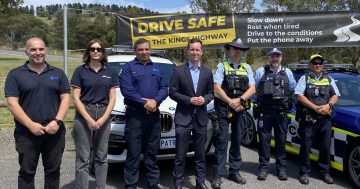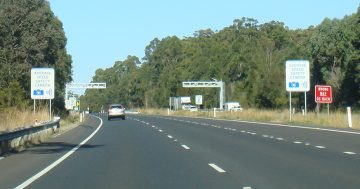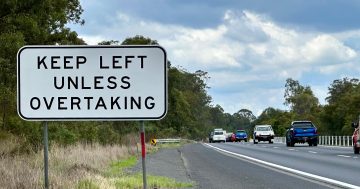
Warning notices are currently being issued to those caught using their phones while driving in the ACT. Photo: Claire Fenwicke.
Canberra’s mobile detection speed cameras will soon pick up more offences under the ACT’s latest road safety action plan.
The cameras will be in the warning phase until February (when fines will start being handed out), but Transport Minister Chris Steel said their capabilities will be expanded to detect other types of road offences.
“[This includes] unregistered vehicles, people not wearing seatbelts in a vehicle, as well as [working as] speed cameras,” he said.
“There will be a rollout of those capabilities over the coming years.”
Some community members have raised concerns about privacy issues around the cameras and steps have been taken to protect those rights as much as possible.
Offences are detected through artificial intelligence and some aspects of a person are blurred. A human then checks the images to ensure an offence has occurred.
ACT Road Policing Acting Inspector Mark Richardson said people needed to understand these cameras served an important purpose.
“We don’t just watch people doing their thing [in the car], it’s not Big Brother, it’s not a reality show,” he said.
“The whole purpose of these cameras is to keep road users safe.”
Conversations are also occurring between ACT Policing and the government to see if the cameras could be used for officers to track other road offences in Canberra, such as excessive speeding or stolen motor vehicles.
“For us, we really need that real-time intelligence, so if someone’s driving a car that’s detected on an ACT Government-operated camera, and the car is stolen or exceeding the speed limit by 45 k’s an hour, these are things we really need to know because those drivers are a danger to other road users,” Act Insp Richardson said.
“To me, if you are driving a stolen car or driving over 45 k’s an hour, your privacy is literally the least of my concern.
“I think we’d be silly not to see what’s out there and what technology we can use in cooperation with the ACT Government to target dangerous driving.”
The five focus areas of the strategy are dangerous and distracted driving; impaired driving; vulnerable road users; safe roads and infrastructure; and education, awareness, engagement and compliance.
The Legislative Assembly is already considering new laws to introduce fines for low-range drink driving and create a new combined drink/drug driving offence.
Random breath testing and mobile drug detection capabilities of ACT Policing are also being increased.
Mr Steel said a “critical area” was behavioural change and education programs, particularly for at-risk young people.
“Unfortunately, we have seen on our roads many young people actually committing offences when they don’t have a license,” he said.
“So there’s a piece of work we need to do with young people who are already known to many of our organisations, but also through the schooling system, as well to promote positive behaviour on our roads.”
A new program is currently being finalised with PCYC and will be rolled out over the next few years.
More than 30 actions in the plan are expected to be implemented over the next two years.
These include implementing mandatory reporting by health practitioners of conditions affecting a heavy vehicle drivers’ fitness to drive, advocating for changes to screening requirements of heavy vehicle licence holders, consideration of expanding lower speed zones in areas with high risks to vulnerable road users, and the progressive conversion of on-road cycle lanes (on priority routes) to separated cycleways.
Original Article published by Claire Fenwicke on Riotact.















